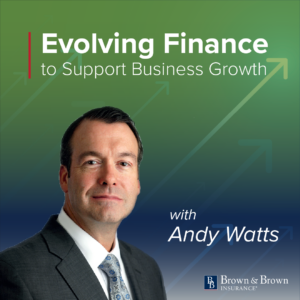The Power of Financial Literacy
by Andy Watts, Executive Vice President & Chief Financial Officer at Brown & Brown Insurance
Most people famously don’t like to talk about religion, politics — or money. Research shows that three-quarters of U.S. adults purposely avoid discussing money with friends.[1] It’s how most of us were raised: Talking about your finances is uncouth or uncomfortable.
I believe this discomfort has more to do with financial illiteracy than a sense of propriety. People are generally afraid to say something ill-informed about managing their wealth or appear ignorant about handling their finances, so they don’t speak up.
This must change.
As many as 57% of people don’t work with a financial advisor[2] or someone that can provide guidance. Even before adulthood, there’s a clear education gap in personal finance in the United States, and it starts with a lack of classroom instruction on the topic.[3] I firmly believe the lack of teaching at school and discussion at home causes our lack of financial literacy.
No matter what profession you go into, everyone needs to be financially literate. Regardless of what you do or how much you are worth, you should be able to answer the following questions:
- How much do you make, and is it consistent?
- How much do you spend?
- What do you spend it on?
- How much are you investing in yourself?
- How are you creating long-term wealth?
My 6-step plan for financial wellness
The power to ensure financial wellness, stability and build your personal wealth is in your hands. Here are some easy steps to empower you to take charge of your financial wellness:
1. Don’t spend more than you make. This may seem obvious, but believe it or not, most people don’t follow this basic tenet of personal finance. Running up your credit cards and getting into insurmountable debt is a recipe for disaster. To ensure you’re spending wisely, start by writing down all your expenses, including the discretionary spending (e.g., each trip to Starbucks, Uber Eats, etc.). Many people don’t even realize where they’re spending their money, so this step helps them identify those unnecessary expenses that add up.
2. Set a goal and commit to the plan. Saving that first dollar is the hardest part, but once you’ve set a goal (that could be short-term or long-term), each dollar you save and each year that goes by makes this part of your standard process. The first year is a 100% increase from what you’d been doing before. The following year is just an incremental increase, which is much easier. Your saving rate can increase as your income grows.
3. Build a budget and invest in yourself. You’ve set a goal and committed to the plan; now, you will need a budget and will need to monitor your spending. These go hand in hand. There are plenty of online resources to help you with building a budget. Your employer might provide resources, or you can talk with an advisor at your bank. Have the mentality that you’re investing in yourself. Part of the discretionary funds you’re budgeting should be set aside for that investment.
4. Start early to leverage the power of compounding interest. While that first dollar saved can be tough, the sooner you begin saving and investing your money, the more you’ll make in the long run due to compounding interest.
5. Reset your plan. Life throws many things at you: kids, job changes and unexpected expenses, to name a few. Discipline is key, but also important is your ability to pivot and change the way you’re budgeting and investing as your life evolves. How much you’re saving and what you’re saving for will change, so your strategy should, too.
6. Have discipline. Long-term commitment is tough. Once you stop saving money, it’s incredibly hard to start back up again, so being disciplined about saving for something unexpected, a new home, college tuition, and/or retirement, is crucial. Remain calm; don’t try to predict the market. Stay invested and accept that your investments will go up and down over time, but in the long run, they will grow if you have a balanced and diversified approach. You’ll never figure out the top or bottom of the market; keep in mind that the 10 best days normally follow the 10 worst days (you just don’t know the 10 days). You’re not in control of the market, so focus on what you are in control of instead: how much you spend and how much you allocate to your investments.
Compounding interest is your friend
Compound interest allows your money to grow faster because it’s interest that is calculated on the interest you already have, as well as your original amount. In other words, it’s interest you earn on interest, so it’s a money snowball. The higher your original amount and the higher your return, the faster your savings compound. For example, let’s say you start putting away $833/month at age 25 with a 4% company match, and you earn, on average, a 6% annual return[4], and you retire at age 67. You will have about $4 million at retirement. Every year you wait, the less total wealth you’ll have. A good rule of thumb is remembering that every 5 years that you delay will result in about $1 million less in savings by age 67.
Thoughtfully, Brown & Brown has created great resources to help its people plan and generate long-term wealth. Morgan Stanley helps teammates create a financial plan and budget for their households via an online resource tool that starts them off with a financial advisor and puts them on the right track.
Brown & Brown also offers resources from Charles Schwab, its 401(k) administrator. Charles Schwab answers personal finance questions from annual maxes to auto-escalation to how to start a Roth IRA.
Additionally, many of my teammates are stockholders in Brown & Brown (check out NYSE: BRO). I firmly believe that owning a portion of your organization demands a different level of commitment to the company. It carries an extra level of dedication to your team, customers, carrier partners and shareholders. Businesses that help their employees maximize wealth creation stand ripe for growth. Period.
Once you realize it’s okay to talk about money and to ask questions, you’ll realize that the compounding power of your current and future financial wealth creation is in your hands — and it’s easier to build than you think.
[1] Empower “62% of Americans don’t talk about money according to new Empower research, and their silence may come at a cost,” April 19, 2023.
[2] Statista “Share of Americans who work with a financial advisor in 2022,” September 8, 2022.
[3] CNBC “Lack of financial literacy cost 15% of adults at least $10,000 in 2022. Here’s how the rest fared,” January 19, 2023.
[4] NerdWallet “What Is the Average Stock Market Return?” May 30, 2023.

Evolving Finance
to Support Business Growth
with Andy Watts, Executive Vice President & Chief Financial Officer at Brown & Brown Insurance
Subscribe to Andy’s Evolving Finance monthly newsletter and view this blog on LinkedIn here.








